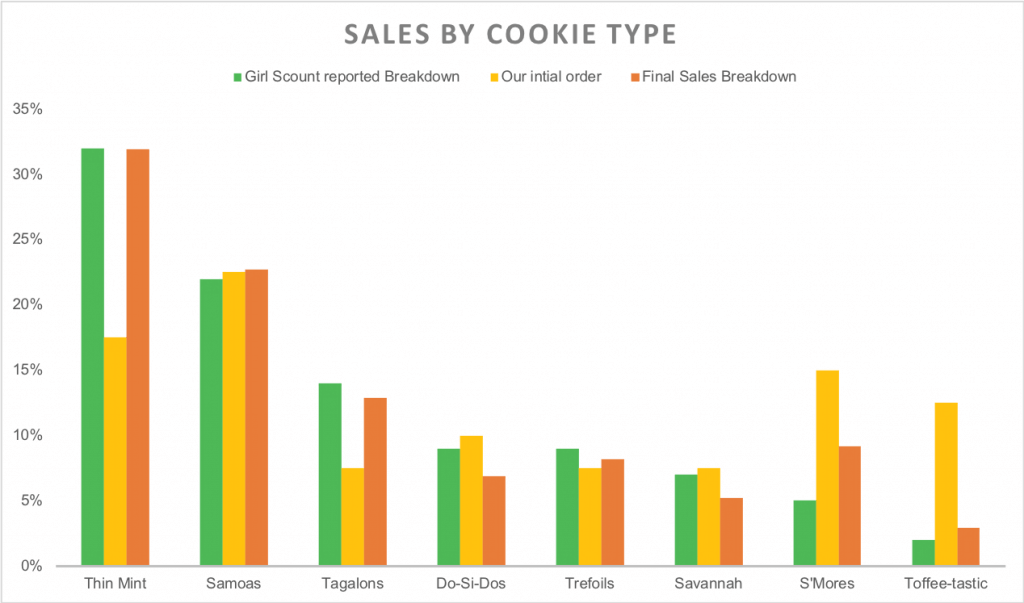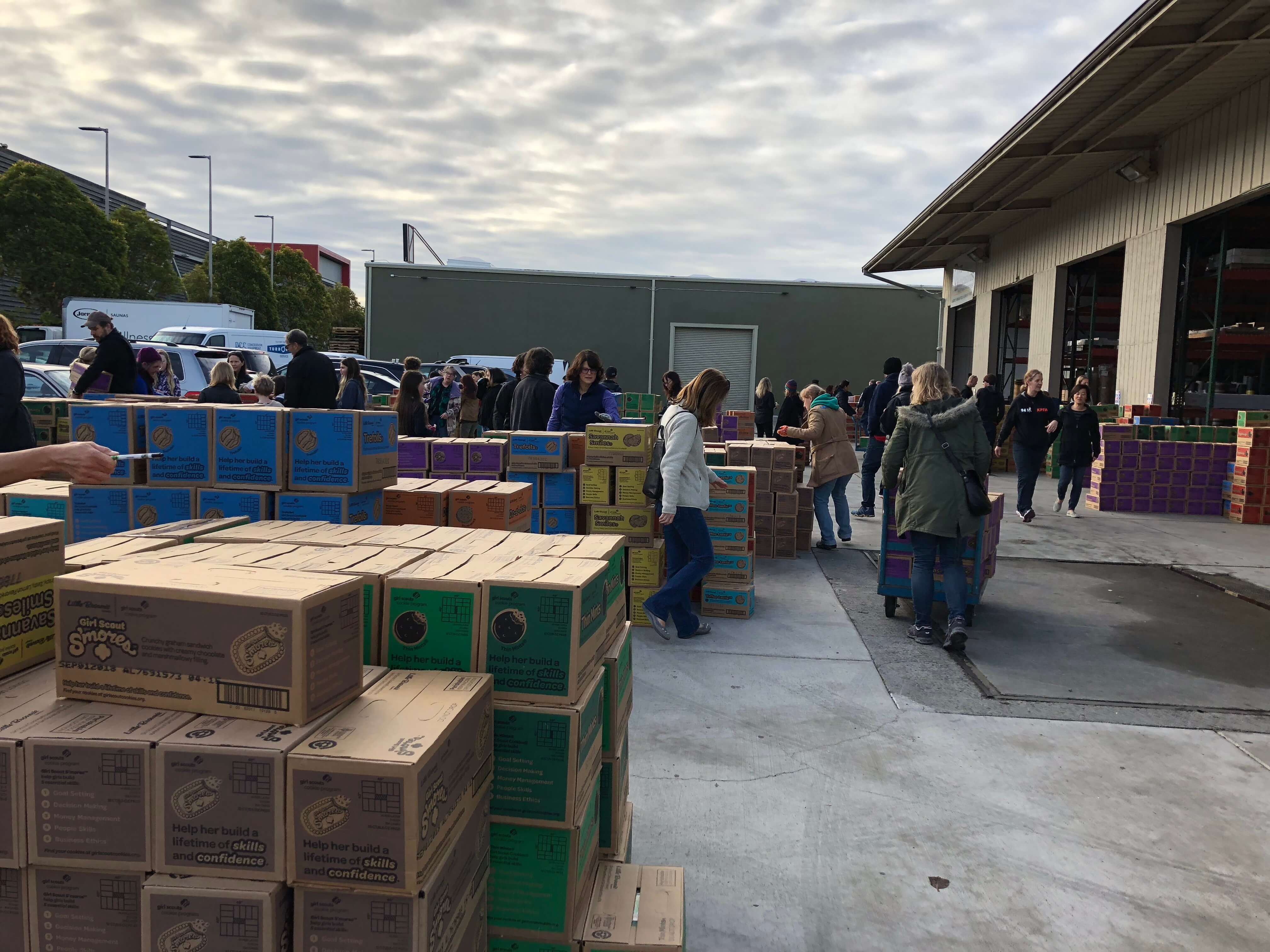Unless you’ve been living under a rock, I’m sure you know it’s Girl Scout cookie time. As the head of Inspirage marketing for nearly 5 years, I’ve been enmeshed with the supply chain challenges our customers face, but unlike our consultants, my view of these challenges has been more academic than tangible. This year, in my first time overseeing my daughter’s cookie sales, I now see these supply chain concepts coming to life in the microcosm of our 12-member troop.
Mind you, Girl Scouts of America (aka “corporate”) and our local council have a pretty awesome system and have made a ton of resources available to help us through the process, so I take full responsibility for any mistakes made during this cookie season. But this process has reminded me of the disconnect between corporate intentions, and what happens in the real world.
Lesson 1: Sales & Operations Planning – Trust the Data
My sales team consisted of twelve 6- and 7-year-old girls (or, truthfully, their parents), so their forecasts were quite vague and non-committal. As a result, my S&OP process was pretty weak, and we really struggled in placing our initial order. The chart below shows how our initial order deviated from standard metrics, but in the end our overall sales will almost exactly match Girl Scout overall numbers.

So why would we make this unforced error? There are a couple reasons:
- We relied too heavily on an “expert” (i.e., friend’s anecdotal data from one day of booth sales last year) vs. broader data from “corporate.”
- We worried too much about running out of specialty cookies (Toffee Tastics or S’mores), which we couldn’t reorder and didn’t worry enough about top-selling varieties coming out of the gate (Thin Mints and Tagalons).
- We were influenced by our own personal preferences, which is always a huge mistake (I’m a Trefoil fan!).
- The overall stats were buried in the user manual vs. readily available in the ordering system and I didn’t spend enough time validating our estimate against the data available.
And the impact is similar to what any organization might see:
- Lost sales – We stocked out of Thin Mints and Tagalons for our first booth sales day.
- Increased operating costs – Because we had to re-order, which means extra time running around.
- Negative environmental impact – Wasted fuel transferring inventory to and from our “cupboard” in a service area volunteer’s garage (aka distribution center).
- Excess inventory – I was able to transfer my excess Toffee-tastics to other troops, but I think I’ll end up with a lot of extra S’mores (I think several other troops were guilty of the same mistakes)!
Too bad I didn’t rely on a single source of truth as I did my planning.
Another interesting parallel that’s representative of any sales org: Our top 2 sellers accounted for 42% of our total sales.

Cookie distribution day – an impressive logistical orchestration.
Lesson 2: Inventory Management is 50% System | 50% Process
Let me tell you our inventory was a mess. For our first booth sales, I grabbed a bunch of inventory without taking note of how much and expected my sales team to tick off how much of each type they sold. At the end of the day, folks would throw boxes into the warehouse (aka garage) in with the rest of my inventory and hand me a huge wad of cash with random tick marks on my inventory tracking sheet. I should have remembered that even our seasoned salespeople are pretty lax about tracking sales in our CRM, so why would I expect 6- and 7-year-olds to be any better with documentation? Oops!
So what would I do differently? The process needs checks and balances that assume humans won’t do what you ask them to do. Had I spent a couple minutes updated my inventory levels as people checked cookies in and out of the warehouse, I could have saved myself hours doing physical counts and reconciling them against the records after the fact. There’s even a mobile app for me to do so.
Maybe one day, Girl Scouts will soon offer a sophisticated warehouse management solution with barcode scanning like Oracle WMS Cloud to help that troop managers track inventory going in and out of the warehouse, but in the meantime, manual entry is better than nothing.
Lesson 3: Change Management is Key
Girl Scouts have been selling cookies in some form for 101 years and have invested quite a bit into systems, training, and documentation to help troops manage these sales. Like any system, they may not be perfect (or perfectly integrated) but they’re perfectly fine. But instead of investing my time in exploring the features of the systems I was provided with, I went to my default comfort zone: my own ad hoc crazy spreadsheet that did the same thing as the system they provided, but not as accurately or efficiently.
This reminds me of a project I was on early in my consulting career (before I went into marketing), when I was presenting the “as is” of what the users were doing in the field where the client in corporate HQ freaked out and insisted they don’t do it that way because it’s not how it’s outlined in the user manual. Well, I think we all know that what is actually done by users is rarely what we want them to do. Training and retraining are key as people, like me, will build workarounds because it seems expeditious.
In my role here at Inspirage, I often find myself wondering why our sales team is using outdated materials or not using our systems as I need them to. “Why didn’t you use the system? We had that one call and I emailed out the training material and documentation.” It’s right there! But we human beings have a shorter attention span than a goldfish, and humans typically use the most expeditious approach vs. how management plans.
Girl Scouts offered a ton of great training, but sometimes it’s overwhelming (especially if you’re new). Change Management isn’t just a one-and-done thing and you need to ease your new users into adopting a new system or process. It’s not just the system administrator’s responsibility to provide the training, users have to meet you halfway, but the administrator needs to provide a compelling reason why you should use the system correctly.
Support Your Local Girl Scouts

Across the nation this month, girls are selling their hearts out, and if you bought some, thank you. While the troops receive a small portion of the proceeds, most of the money goes to fund national and regional programming. More importantly, these lessons these girls learn from selling cookies, coupled with Girl Scout’s pledge to send 2.5 million girls through hands-on STEM programs by 2025, sets the foundation for our next generation of supply chain leaders. In the meantime, maybe those of us in the industry can learn a few things from these young cookie sellers.
PS – If anyone is hankering from some Girl Scout S’Mores – drop me a line and I can hook you up!